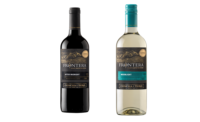Hot Pockets Appeals to Video-Gaming Teens with Brand Redesign

Courtesy of Designalytics
The Hot Pockets brand was created in 1983 as a tasty and filling microwavable snack, and steadily became a freezer staple and a pop-culture mainstay for kids during the 1980s and 1990s.
A lot has changed since in the ensuing years, and many of the kids who once snacked on those handheld sandwiches are now parents looking for heat-and-eat goodness for their own kids. Somehow, life seems busier than ever, so the combination of taste and convenience that drove Hot Pockets’ popularity remains a big advantage for the brand. Yet its package design hadn’t kept pace with shifting market dynamics, and it became clear that a repositioning was in order.
For example, Hot Pockets no longer wanted to appeal just to the buyer (most often parents) but to the eater as well—specifically, 13–17-year-old video game enthusiasts, which were the target demographic. “We wanted something more experiential for the teen eater, but something that parents still felt really good about,” said Tom Davie, brand identity and design manager at Nestle, which owns Hot Pockets.
Hot Pockets trusted Interact Brands, the esteemed Boulder-based branding and design agency, with this reinvention. Fred Hart, partner and creative director at Interact, noted that the repositioning would actually support marketing partnerships and efforts that were already established. “Hot Pockets already had alignments with gaming companies and eSports teams,” he said. “They now needed a brand identity system and package design that followed through on this new repositioning of the brand.”
The goal was to create a package design that captured Hot Pockets’ target demographic—which the brand coined the “Witty Misfit”—and that won over both the buyer and the eater. Hart said the brand should simply focus on being a more self-assured, committed, and strategic version of what it already was, rather than shooting for a complete transformation. “It was important that the brand not try to be a gamer,” Hart remarked. “Teens can smell BS from brands, and they demand authenticity. Hot Pockets just needed to act with confidence and it would naturally fit into the lifestyle of a gamer.”
As the creative brief was being honed, the challenges became more distinct. For one, the brand had a prolific portfolio—more than 50 SKUs that included different ingredients, crust flavors, and more—meaning there would be quite a few moving parts. Plus, there was the inherent risk of changing a beloved brand’s look. Hart had navigated similar situations before, though. “Consumers don’t read, they recognize. So anytime you get your hands on a pre-existing brand, you need to maintain the things that people recognize about it. At the same time, I think brand managers are often a lot more conservative than consumers are.”
And Hot Pockets was open to ideas, in spite of its status as a category leader. “We gave Interact free rein in creative exploration,” recalled Davie. “We were open-minded as to what it might look like on the shelf.” Interact presented a range of options, including ones far from the usual. As the brand winnowed down the options, it also checked in with its most important constituency. “As we went through the workflow and started talking with consumers, we put guardrails in when it was warranted.”
One of the most noticeable changes is to the logo. The holding shape around the brand name remains (research confirmed for Davie that it was an essential asset), though it’s now white like the font—thus making it bolder and more noticeable. The new look also ditches the serif font for a more modern, playful, and bright-white font. Hart points out that the jumble of letters aligns with both the “misfit” vibe while evoking the snack itself, barely containing the goodness within. “We made the holding shape much more round as if it's literally the opening of a Hot Pocket, and there’s some funkiness and personality to the font, especially the ‘k-e-t.’ It looks as if it's crammed in there like the ingredients.”
As with any food product, appetite appeal was key, and there was an opportunity to improve upon the previous design with some simple choices. The brand brought in an expert in food photography, Chicago-based Brian Wright, to make its vision a reality. “First, we stacked two Hot Pockets on top of one another, versus just one—basically doubling the appetite appeal in a similar space,” Davie commented. “Plus, in the previous version, you saw 80% crust, and maybe 20% filling. With a subtle shift of the camera, you can now see so much more of what makes this product delicious.”
Hart noted that the photography obviously appeals to the taste buds of teens, but it also sends a message to the buyer. “Parents care about satiety, and the imagery helps them see how substantial a snack this is. Plus, by showing two Hot Pockets rather than just one, it feels like more of a value since it stretches their dollar further.”
Of course, such an established brand wouldn’t want to make any decisions about a design without checking in with both the eater and the shopper. Davie noted an interesting dynamic during this research—teens focused more on what their parent or guardian would want to see in the package design, rather than what they preferred themselves. “The teens were thinking incredibly strategically,” Davie recalled. “In order to get what they wanted, they understood that the design would need to speak to their parents. It was sort of ‘make it as cool as you can, but don’t oversell it’ and ‘keep that protein claim in there so my mom can see it’s good for me.’”
Ultimately, that perspective helped guide the design in a direction Davie hadn’t anticipated. “The new design wasn’t as revolutionary as we thought it was going to be at the start. And that was because these teens felt that the more revolutionary it became, the more hesitant their parents would become in choosing to purchase it.”
The redesign was a smashing success. In the 6 months following the launch of the new design, Hot Pockets’ sales increased by 39% compared to the same period during the prior year.
When asked what he thought made the redesign so successful, Hart said: “I think it was a real commitment to our audience. That’s harder to do when you’re a bigger brand, because you instinctively think your audience is so much broader and you need to appeal to everyone. I really have to give credit to the Nestle and Hot Pockets team for that commitment.”
For his part, Davie is appreciative that Interact delivered a successful outcome that balanced several requirements. “Fred and his team were committed to creating a package design that embodies Hot Pockets personality and wins with both teen gamers and parents. They did a really fantastic job.”
Looking for a reprint of this article?
From high-res PDFs to custom plaques, order your copy today!







